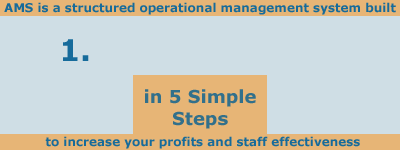 |
|
 |
 |
Management is
the “scientific art of directing all actions with a degree of
skill so as to alter the system to increase value for all
constituents”.
The
Action Management System was developed
by
Action Management
Solutions as a complete system to help
small and medium business owners better manage and improve
their businesses.
AMS should be viewed as three
components:
(1) The management PROCESS (the AMS
method)..
(2) The Business Management NAVIGATOR (the
software).
(3) The operational KNOWLEDGEBASE (the business
information and tools to run the business).
AMS
creates a management environment in which each and every
person focuses on specific actions that reduce risks and add
value to improve the business to become more
competitive and more profitable. AMS supports all
staff with details of all actions required of them by the
business. AMS is integrated so that management and staff have
complete transparency of operations to bring “peace of mind”
to Directors.
Look at the
Benefits (click
here).
|
|
Action Management for
your Company is a simple and fast 5-step "how to"
process that leads to the creation of a Business Management
Navigator that improves day-to-day business
operations . The Navigator includes the performance management
of all business areas assigned to all managers and staff.
|

Take-a-Tour of our
Internet-AMS
capability
|
The Action Management System is then
integrated with a shared Knowledgebase (built as a
key component of AMS) that will evolve to contain all the
procedures, tools, and documents that are used to run the whole
business. A complete AMS will
therefore include all the processes that staff need to
achieve their targeted performance measures. To achieve this, the
AMS Navigator is securely linked to all
staff performance reviews that are accessed online only
by authorised staff. The Navigator is also used
to collect and test new business initiatives, validate new
business ideas, and to track all business improvement projects and
incidents.
The simple 5-step process (see
Diagram above) is summarised below:
(1)
Create your Business DNA
AMS guides management in the development of a value-based
structured analysis of the business. Managers work with staff to
ascertain precisely on what, and how employees spend their
time. AMS then assists senior management to establish the key
operating success criteria and critical operating actions required
to drive the new Business DNA.
(2) Assign
Accountability to People
AMS provides the process for
management to assign personnel to cover all DNA Action
areas and to build links to other business information. Staff
roles are then developed that are a direct reflection and
implementation of the Business DNA. AMS guides you through the
definition of performance measures for all staff Actions (within
their roles) and establishes the resources required for staff
to implement all their Actions.
(3) Assess Risks to the
Business
The CEO and the senior team jointly undertake a
complete Risk Analysis of all elements of the new Business DNA.
This comprehensive analysis is then integrated
into the Business DNA which then gives a concise graphical
overall view of the "health" of the business.
(4)
Identify and Implement Improvements
AMS provides
management with a method of reviewing, consolidating,
documenting, and evaluating all operational Actions and
generating new Ideas and Recommendations required for the
continued improvement of the business.
(5) Measure
Non-Financial Performance
Throughout steps (1) to (4)
AMS evolves into a customised business performance system of Company
operations. This system is then used by the CEO and Management as an
operational Business System that optimises and measures business
actions to create maximum business value. Reporting systems are
established as required.
(More AMS
information in the form of a PowerPoint presentation
(1.3MB) can be viewed here).
The Action Management System can
also be thought of as an Operational Risk Management
System. The CEO can instantly view Hot Spots
and identify the highest risk areas in the business that are likely
to jeopardize the immediate future profits, performance, costs, or
service levels in the business. |
 |
 |
 |

Next Step

is to build
the
unique "DNA" for your
business |




